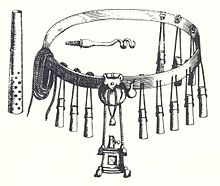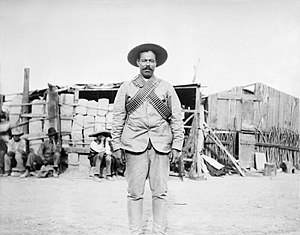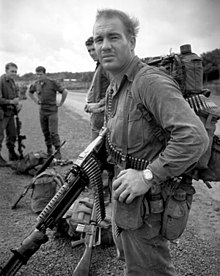Bandolier
The bandolier (also bandolier or bandalier ; French bandoulière or Spanish bandolera , "ribbon") is a wide leather strap that is placed over the shoulder and worn diagonally across the upper body, to which military equipment was attached, which due to its weight would not fit well on the belt or waist belt let carry.
Use (historical)

With the advent of firearms , shooters not only had to carry the actual weapon, but also the ammunition that went with it . Attached to the rifle bandolier were:
- a leather ball bag with balls; Reichsnorm was a ball weight of 2 Lot Nuremberg weight (about 30 grams), i.e. H. 16 bullets on 1 pound of lead
- a little flask called pulverine , a small flask with fine flour powder (" fiery herb ") for the ignition pan ;
- ten to twelve small wooden cans ("apostles") with a measured amount of powder for one shot each, which were later replaced by containers (i.e. cartridges ) made of paper - the first for the cavalry . The amount of powder should be 2/3 of the weight of the ball, i.e. about 20 grams or 320 grains of black powder .
- a tin vial of oil to grease the stoppers;
- the folded fuse - a hemp rope soaked in lead sugar that could glow for hours;
- a broach to clean the ignition hole .
These items were attached to the bandolier with leather straps. The Regensburg city bishop Alexander von Haslang recommended in a pattern book in 1606, however, that one should not use “lidere rhüemlein (leather straps)”, but “good, starckhe treads schnierlein (twisted cords)”, “which rain too much be able to endure, then the little belts rot the next one (because the little belts rot at times) ”. All together weighed about 3.8 kilograms.
A sword could also be attached to its own bandolier, with grenadiers carrying grenade pouches. The mounted riflemen wore their arquebuses on a bandolier so that they would not be lost in battle. "For this purpose, the bandolier had a special hook, the snap hook, which engaged in a ring that was attached to the arquebus shaft so that it could be moved on a rod". They were therefore also referred to as bandolier riders.
From the middle of the 17th century, the paper cartridges were housed in a cartridge pouch ( cartridge ) that was still carried on a bandolier.
From the beginning of the 18th to the middle of the 19th century, the infantry sometimes carried the double or cruciate bandolier over both shoulders: the cartridge pouch hung on one bandolier, the side gun on the other .
In the late 19th century and at the beginning of the 20th century, the bandolier was an ornament for the mounted troops, which was worn over the left shoulder and was decorated with gold or silver braids for the officers , the cartouche hanging on it was with an eagle, Star, coat of arms or name occupied.
Use (20th / 21st century)
In non-European countries, mainly in America and Latin America, bandeliers were also worn, on which a large number of individual cartridges for the firearm, rifle or revolver, looped like a machine-gun belt , were carried. Some of the cartridges were held in place by leather flaps, and the belt was worn as a cartridge belt over the waistband or crossed over the shoulder. For hot and humid climates, the leather of some belts was replaced by cotton, which reduced corrosion on the brass cartridges and was cheaper to manufacture.
The bandeliers used by the military today are made of dyed nylon or other fabrics; In the half or full-sided covered pockets there is space for a magazine for the main weapon, the assault rifle ; alternatively, smaller items of equipment such as a compass, first aid kit or hand grenades can be transported. As a rule, there are no other fastening options, such as those for the regularly worn harness, or they are improvised, the bandolier is intended more as a cheap and quick-to-make addition. This bandolier - mostly worn individually at an angle over the shoulder - can be seen in numerous pictures from the Vietnam War .
The rather seldom found cut-up way of wearing suspenders can be regarded as the forerunner of today's webbings and was produced during the First World War. Worn with suspender belts as a belt, another form was common in Vietnam and the neighboring countries for a long time.
See also
literature
- Georg Ortenburg: Weapons and the use of weapons in the age of the mercenaries. Bernard & Graefe Verlag, Koblenz 1984, ISBN 3-7637-5461-X , pp. 62f and 183.
- Dr. Peter-Christoph Storm: The Swabian Circle as a general. Writings on the history of the constitution, Volume 21, Duncker & Humblot Berlin, 1974, ISBN 3-428-03033-8 .
- Adoph Menzel: The army of Frederick the Great in their uniform. Verlag Martin Oldenbuorg, Berlin 1908; Reprint Weltbild GmbH, Augsburg 2005, ISBN 3-8289-0523-4 .
- Johann Jakob von Wallhausen: The art of war on foot. Oppenheim 1615.



